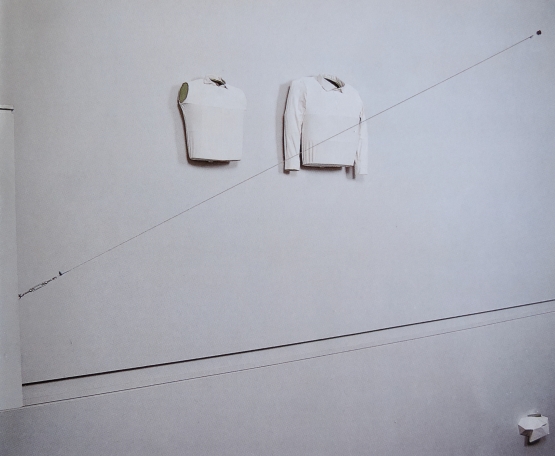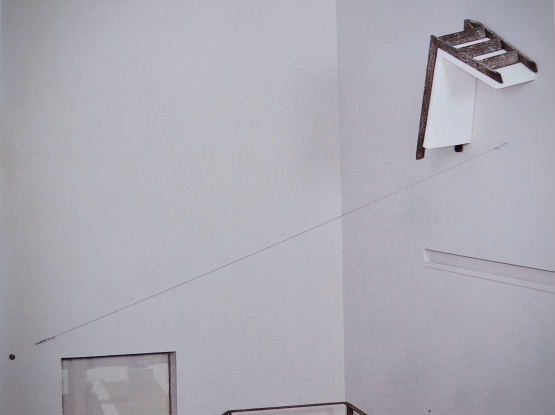SCENERY FOR THE FALL OF A VOICE
The works of Miguel Angelo Rocha were acknowledged in the beginning of this decade as articulated deconstructions of both painting and sculpture. The wall as a privileged place, traditionally reserved for painting is where this
·work demonstrates a marriage of the possibilities of both disciplines. In the case of the present exhibition, the works establish relations that re-shape the surrounding space, assuming the qualities of an installation. It is, however, important to emphasise the role of the gallery's architecture; the selection of the materials and the search for their possibilities reveals the unexpected: the recurring white canvas, usually painted, shows tri-dimensional qualities, while the steel cables draw lines that articulate different elements leaving
a powerful impression. The appropriated or quoted object by means of a cast has a sculptural quality and is, directly or not, a manifestation of the presence of the body. Its contrast with the other pieces leaves a sense of precarious equilibrium. A white chromaticism gives an aseptic feel to the pieces, creating the atmosphere of a hospital, a situation of life and death.
Since his first exhibition the theme of the relation between what is organic and inorganic has been revealed as a fertile ground for experimentation. In certain cases his works articulate figurative fragments related to the presence of a body with abstract forms of a primary geometry giving different distortions which are only the effect of an energy that tries to transcend itself. This paradigm works to confront the body (or what stands for it)with its possibilities. In this sense Miguel Angelo Rocha has produced an autonomous work based on a critical understanding of the Museu do Chiado's modernist collection. The reference to Mario Eloy's work, a major figure in Portuguese expressionism is made pertinent by Rocha in that it is the articulation of organic and crystalline polarities, thus assuming a conflict between the empathy of expression and the classicization of the form.
Obviously, Rocha's context is a different one although it is significant
to recognise the curious similarity of polarities as part of their concept. Thus, the body, the crystal, a ladder and several loudspeakers create a disturbing relation. The sculpturally constructed torsos, made of canvas and stretcher - show a stiff posture alluding to Eloy’s self-portrait. Displayed side by side, a tight steel cable imposed diagonally in front ending in a loudspeaker, calls into question the problem of communication as a decisive issue on the making of the subject; the muteness of the loudspeakers refers to this, allowing for an allusive or even projective universe in the mind of the viewer, urging them to question the meanings and inter-relations that the works establish. The "bended" ladder, in a deconstructive, irrational manner, draws an implausibility in the global process - the myth of the fall. This is not a traditional symbol of transcendency but the sign of a fear. In opposition to the physical tension suggested in the stiffness of the torsos, the crystalline structure implies an unarticulated limb that once was connected. This piece functions as the consequent crystallisation of the process, the menacing pole of the dynamics of the relational universe. With no possibility of making a communicational circuit, the formalisation happens not as the surpassing of the process but as the result of its bankruptcy.
However, the omnipresence of the body in the installation assumes a wide
fragmentation and reconsideration of its parts in the absence of its wholeness. With the whole body as a subject another concept surfaces with its semantics irreducible in themselves, divided in different experiments. Its conceptualisation is absolute and seems to evolve from an hubris, the desire to overcome the architecture of “natural" possibilities, thus, building itself from will. Nevertheless, the narrative from which the work is drawn is of a total disintegration of the subject which, keeping in mind the language game of each piece,
eliminates the possibility of a common denominator.
Thus, the "post human" era, the re-inventions of the body, do not reconstruct the subject, instead it is the threshold of these parts that receive autonomy from the whole and possibly closely depend on the will that controls them.
Pedro Lapa
June 1996

Bar Gallery
entry: General ConditionsPortraits of Mário Eloy
Miguel Ângelo Rocha
1996-07-12
1996-12-31
Curatorship: Pedro Lapa
On Exhibition
The Ascension of Mont Ventoux
Manuel Valente Alves
2025-10-26
2026-02-16
Curatorship: Lúcia Saldanha
Photographs, drawings and paintings, by Manuel Valente Alves that develop a poetic dialogue with Petrarch's letter of the same name (Ascensus Montis Ventosi), written in 1336.
.
2025-10-16
2026-02-01
Curatorship: Susana Lourenço Marques, Emília Tavares
This exhibition, in partnership with the Porto Museum, presents the work of three amateur photographers - Margarida Relvas, Mariana Relvas and Maria da Conceição de Lemos Magalhães - developed in Portugal between 1860-1920.
Mily Possoz. A poetics of space
2025-10-01
2026-02-01
Curatorship: Emília Ferreira
The exhibition “Mily Possoz. A Poetics of Space” continues the research into the lesser-studied Portuguese modernists artists present in the collections of the MNAC and Millennium bcp.
Impressões Digitais. MNAC Collection
2024-12-12
2026-12-30
Curatorship: Ana Guimarães, Emília Ferreira, Maria de Aires Silveira e Tiago Beirão Veiga
Consisting of founding works of contemporary Portuguese art historiography, from 1850 to the present day, the MNAC's collection holds several national treasures.
Since 1911
2022-05-26
2026-05-26
An intervention that celebrates 110 years of the MNAC.











